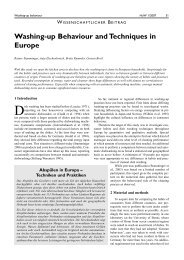Old Washing Machines Wash Less Efficiently and Consume More ...
Old Washing Machines Wash Less Efficiently and Consume More ...
Old Washing Machines Wash Less Efficiently and Consume More ...
Create successful ePaper yourself
Turn your PDF publications into a flip-book with our unique Google optimized e-Paper software.
128 HuW 3/2005 Comparison Between <strong>Old</strong> <strong>and</strong> New <strong><strong>Wash</strong>ing</strong> Maschines<br />
average, consumers use only about three quards of washing<br />
machines’ maximum rated capacities.<br />
Four test runs were carried out for each parameter setting,<br />
<strong>and</strong> usage of water <strong>and</strong> energy <strong>and</strong> performance data were<br />
recorded. Performance was measured (as is common practice<br />
in testing washing machines) by adding artificially soiled<br />
swatches to the wash <strong>and</strong> measuring their level of whiteness<br />
afterwards. A Wascator CLS washing machine was used as a<br />
reference machine to calculate the index of washing performance<br />
<strong>and</strong> to transfer it to class of performance<br />
as used in the European Energy<br />
Label system (EC95/ 12 1995). All<br />
other conditions followed international<br />
st<strong>and</strong>ards (IEC 60456 2003).<br />
Tests using nominal (100 %) Load<br />
amounts of detergent were performed for<br />
40, 60 <strong>and</strong> 90 °C cotton programmes. In<br />
addition, the machines were operated<br />
with reduced (50 %) <strong>and</strong> increased Programme<br />
(150 %) doses of detergent in the 60 °C<br />
cotton programme. This was intended to<br />
take account of the flexibility of users in<br />
adjusting the performance of their washing<br />
machines by choosing different<br />
temperatures or by varying the amount<br />
of detergent.<br />
Dosage<br />
4.2 Test Results<br />
The results are presented here in<br />
terms of the index system <strong>and</strong> class definitions<br />
of washing efficiency as known<br />
from European energy labelling, alt-<br />
W ISSENSCHAFTLICHER B EITRAG<br />
Figure 4: Calculated average energy <strong>and</strong> water usage for a 5 kg cotton wash by<br />
year of manufacture of washing machine<br />
energy in kWh<br />
5.0<br />
4.0<br />
3.0<br />
2.0<br />
1.0<br />
0.0<br />
1970 1975 1980 1985 1990 1995 2000 2004<br />
Source: Own representation<br />
Line is for visualisation only<br />
year of production<br />
energy for 90 °C cotton<br />
energy for 60 °C cotton<br />
energy for 40 °C cotton<br />
energy for 30 °C cotton<br />
water consumption for all<br />
programmes<br />
hough the test conditions were not all<br />
according to the definitions for this<br />
system. Nevertheless, a three-dimensional<br />
plot of the performance fields (Fig. 5)<br />
which washing machines can achieve<br />
depending on the amount of detergent<br />
used <strong>and</strong> on the temperature selected,<br />
provides the best overview of the results.<br />
It is evident that the same level of performance<br />
can be achieved (Fig. 5a) in a<br />
90 °C programme with only 50 % of the<br />
rated detergent dose, in a 60 °C programme<br />
with rated detergent dosage, or in a<br />
40 °C programme with 150 % of the<br />
rated detergent dose. Thus, consumers<br />
are basically free to select any one of these<br />
options to achieve a specific level of<br />
cleaning performance, the only limitation<br />
being the temperature stability of the<br />
fabrics to be washed.<br />
Other washing machines, particularly<br />
older ones, have similar performance<br />
fields, but their absolute values are considerably<br />
lower, <strong>and</strong> their slopes show an<br />
increased influence of dosage <strong>and</strong> tempe-<br />
rature on washing performance (Fig. 5b). A synopsis of the<br />
60 °C cotton cycle measurements for all three detergent<br />
dosages (Fig. 6) shows that performance, in addition to varying<br />
greatly between machines, can be adjusted effectively via<br />
detergent dosage. This becomes even more obvious if the<br />
results are rated according to the European Energy Label<br />
index of washing performance, in which machines are graded<br />
in classes of 0.03 width ranging from A (best) to G<br />
(worst). <strong>Old</strong>er machines rarely achieve class A performance<br />
Table 3: Test conditions for all washing machines<br />
Characteristics Data <strong>and</strong> parameters<br />
Mass 4.0 kg<br />
Textiles (IEC 60456) 2 sheets, 4 pillowcases, 14 terry towels<br />
Kind Cotton without pre-wash<br />
Temperature<br />
Detergent (IEC 60456)<br />
40 °C, 60 °C, 90 °C<br />
Composition 77 % IEC A*, 20 % SPB4, 3 % TAED<br />
40 °C 118 g ( = 100 %)<br />
60 °C 59 g ( = 50 %), 118 g ( = 100 %), 177 g ( = 150 %)<br />
90 °C 118 g ( = 100 %)<br />
Source: Own representation<br />
250<br />
200<br />
150<br />
100<br />
50<br />
0<br />
water in l





